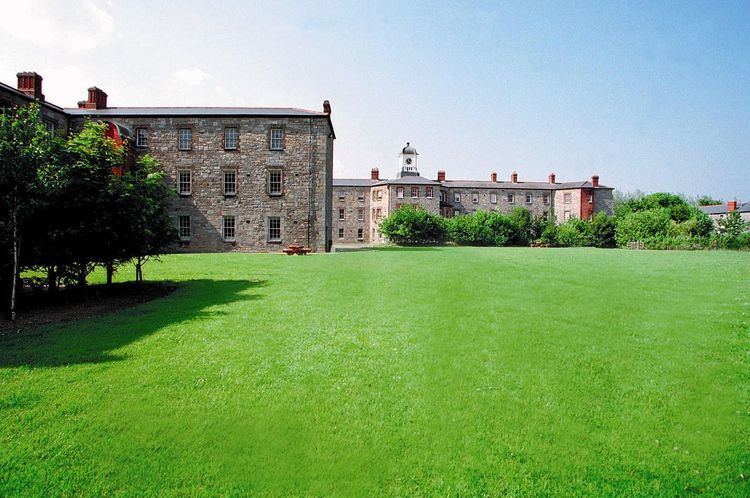Type Barracks In use 1892-1992 Year built 1892 | Phone +353 1 454 7278 Province Leinster | |
 | ||
Similar Wellington Barracks, Collins Barracks - Dublin, Little Sugar Loaf, James Joyce Centre, The National Wax Mus | ||
The bizfactor griffith barracks mdns
Griffith Barracks (Irish: Dún Uí Ghríofa) is a former military barracks located on the South Circular Road, Dublin, Ireland.
Contents
- The bizfactor griffith barracks mdns
- Scoil osag in crumlin vs griffith barracks
- History
- 1916 Rising
- Civil War
- Boxing
- Buildings
- Closure
- References
Scoil osag in crumlin vs griffith barracks
History
The site of Griffith Barracks was originally known as Grimswoods Nurseries. The first buildings on the site were those of a Remand Prison or Bridewell. Begun in 1813 by the architect Francis Johnston, it was built to relieve pressure on the Newgate Prison, Dublin. On the reorganisation of the government following Thomas Drummond's appointment in 1835 as Under Secretary for Ireland, it became a male penitentiary, "The Richmond Pen"; it was also known as "Richmond Gaol".
Cease to do evil; learn to do well was the motto over the door of the Richmond Bridewell.
In 1844 it was linked with Catholic Emancipation and the subsequent movement for Repeal of the Act of Union: one of its most famous occupants was the Liberator, Daniel O'Connell, together with his son John. Prominent Irish Nationalist leaders such as William Smith O'Brien, Thomas Francis Meagher (later Acting Governor of Montana), James Stephens (founder of the IRB) and "Honest" Tom Steele, were among its famous historical prisoners.
Another distinguished inmate was The Lord Mayor of Dublin, Timothy Daniel Sullivan, for publishing The Nation, an Irish nationalist newspaper, in 1887.
In 1887 it was transferred to the War Department. The additions and extensions were completed by 11 November 1893 but prior to that, in summer 1892 a battalion of the Royal Munster Fusiliers was in occupation. In this era it was known as Wellington Barracks after the Duke of Wellington.
During the First World War it was used as a recruiting and training centre for many of the Irish soldiers who fought in that war.
1916 Rising
The Barracks was not attacked during the 1916 rising, though it was sniped at. The British garrison of fewer than 100 men were unarmed when fighting broke out but were reinforced during the Rising. The local Irish Volunteer battalion (4th Dublin) posted scouts to see if the garrison would make a sortie against them, but found no such action.
Civil War
The change from Wellington Barracks to Griffith Barracks occurred on 15 April 1922 when it became one of the first to be handed over to the Irish Free State and was garrisoned by the new Irish Army. It was later renamed by the Army Council in honour of Arthur Griffith, following his death in August 1922.
During the subsequent Irish Civil War (1922-1923), the barracks was attacked by the Anti-Treaty IRA, in an incident in which five people were killed. On November 8, 1922, Anti-Treaty fighters fired on troops drilling in the main square at the barracks from positions across the Grand Canal, using Lewis and Thompson machine guns and rifles. One soldier was killed and fourteen injured (seven seriously), two civilians were also killed and many injured. Free State reinforcments were rushed from Portobello Barracks (now Cathal Brugha), and two of the IRA attackers were killed and six captured, along with a machine gun.
In reprisal for the attack, a Republican, James Spain, was killed. He may have taken part in the attack on the barracks and was wounded in the leg. Two hours after the action, he was pursued by Free State troops, taken out of a nearby house on nearby Donore Avenue and summarily executed.
Boxing
In 1939 part of the barracks was leased to the Irish Amateur Boxing Association as the site for the National Boxing Stadium which was opened by Frank Aiken.
Buildings
Closure
In 1991 the last soldiers left the Barracks and transferred to Cathal Brugha Barracks and the site handed over to the Office of Public Works as part of a government programme of closing a number of military installations around the country.
In 1992 the Barracks was sold by the Office of Public Works and it became the site of Griffith College Dublin. The College has developed on the site with a number of building being refurbished as well as a number of new structures being built.
In 1998 Griffith Barracks National School was opened the Guardhouse building and parade ground site at Griffith Barracks, South Circular Road. It was officially opened by President Mary McAleese in April 1998.
